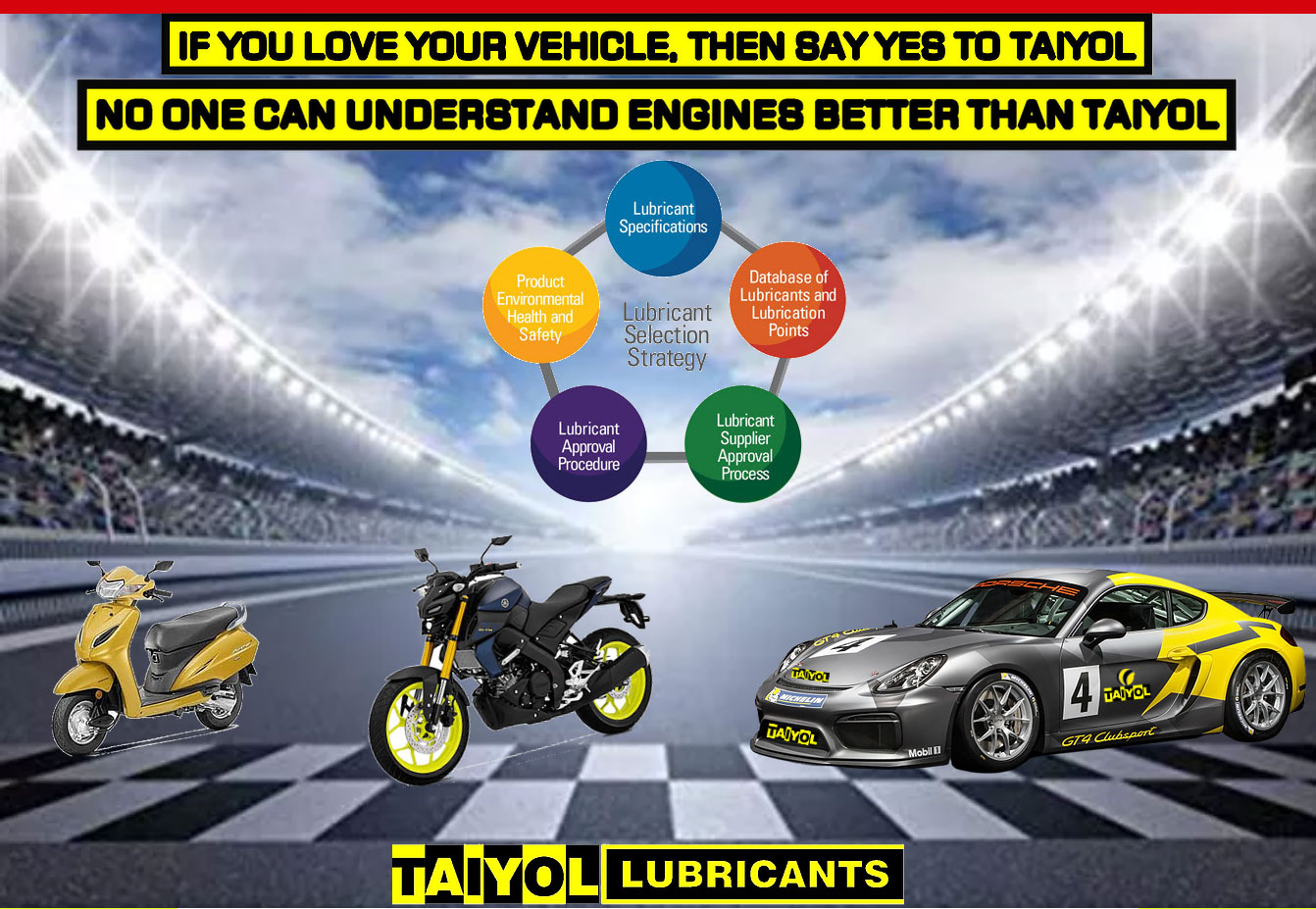
There are two main classification criteria for motor oils:
• Based on Viscosity (SAE)
• Based on Performance (API, ACEA, manufacturer's specifications)
SAE CLASSIFICATION
Kinematic viscosity measured at 100°C defines SAE degrees from 20 to 60 for rising levels of viscosity. Dynamic viscosity at low temperatures defines the SAE "W" degrees, from the initial "winter", from 0W to 25W on the basis of viscosity levels measured at temperatures from -35° to -5°C. The temperature represents the lowest possible temperature at which the engine can be started when lubricated with an oil of the corresponding SAE degree (e.g. a 15W oil makes it possible to start the engine at up to -20°C). The minimum pumping temperature is the minimum temperature at which oil, in addition to allowing start up, can flow freely and lubricate the critical parts of the engine.
SAE J300 JANUARY 2009 (ENGINE OILS)
The most widely used system for engine oil viscosity classification is that established by the Society of Automotive Engineers (SAE) in the USA. In this system two series of viscosity grades are defined – those containing the letter W and those without the letter W. Grades with the letter W are intended for use at lower temperatures and are based on a maximum low temperature viscosity and a maximum borderline pumping temperature, as well as a minimum viscosity at 100°C. The low temperature viscosity is measured by means of a multi-temperature version of ASTM D2602 ‘Method of Test for apparent Viscosity of Motor Oils at Low temperature using the Cold Cranking Simulator’.
Viscosities measured by this method have been found to correlate with engine speeds developed during low temperature cranking. Borderline pumping temperature is measured according to ASTM D3829 ‘Standard Method for Predicting the Borderline Pumping temperature of Engine Oil’. This provides a measure of an oils’ ability to flow to the engine oil pump inlet and provide adequate engine oil pressure during the initial stages of operation.
Oils without the letter W, intended for use at higher temperatures, are based on the viscosity at 100°C only. These are measured by ASTM D445 ‘Method of Test for Kinematic Viscosity of temperature and Opaque Liquids’.
‘multi-grade’ oil is one whose low temperature viscosity and borderline temperature satisfy the requirements of one of the W grades and whose viscosity at 100°C is within the stipulated range of one-W-grades.
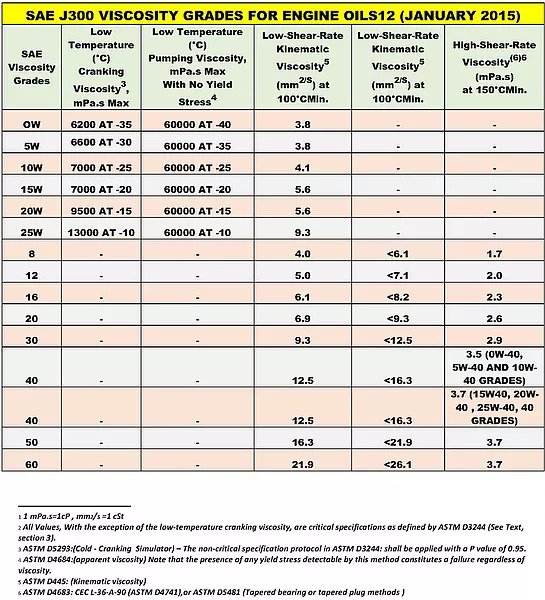
API CLASSIFICATION
API stands for American Petroleum Institute. In 1970 along with the SAE and ASTM (American Society for Testing and Materials), they established the API Service Classification System to define the performance level of a given oil, unrelated in the main, to oil viscosity. The API requirements “S” for Spark Ignition (petrol) and “C” for Compression Ignition (diesel) can be briefly described as follows. For automotive gasoline engines, the latest engine oil service category includes the performance properties of each earlier category. If an automotive owner’s manual calls for API SJ or SL oil, API SM oil will provide full protection. For diesel engines, the latest category usually – but not always – includes the performance properties of an earlier category.
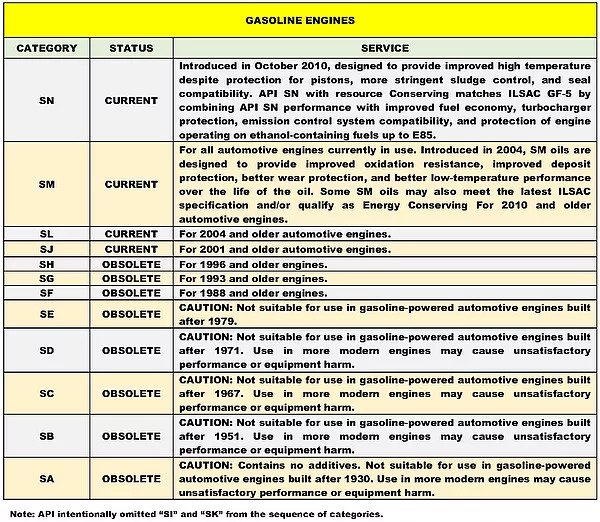
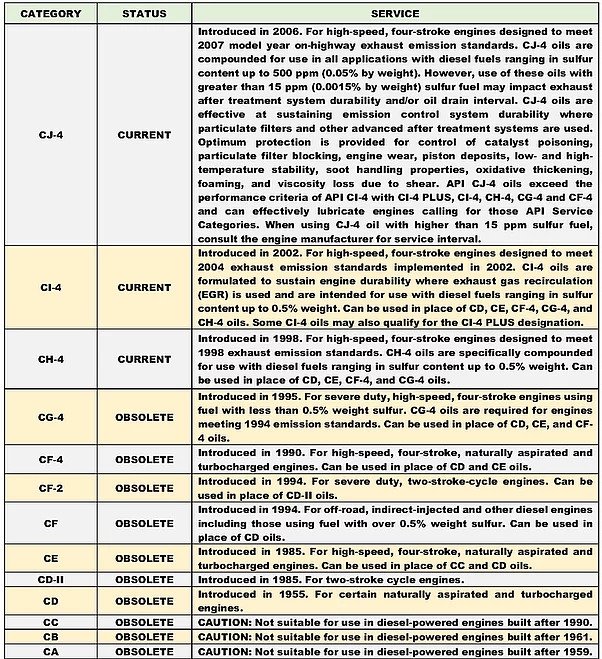
Through the years, lubricant users have been treated to a number of ways to designate viscosity grades of the lubricants used in manufacturing. There are SAE (Society of Automotive Engineers) grades for gear oils and crankcases (engines), AGMA (American Gear Manufacturers Association) grades for gear oils, SUS (Say bolt Universal Seconds), cSt (kinematic viscosity in centistokes), and absolute viscosity. To add to the confusion, two measures of temperature (Fahrenheit and Celsius) can be applied to most of these, not to mention that viscosity might be presented at either 40°C (104°F) or 100°C (212°F). While all of these have served useful purposes to one degree or another, most lubrication practitioners settle on and use one method as a basis for selecting products. To the new entrant into the lubrication field, the number of options can be confusing, particularly if the primary lubricant supplier does not associate one of the prominent viscosity systems to the product label. To complicate matters, machinery designers must define the lubricant viscosity in such a way that the equipment user understands clearly what is needed without having to consult outside advice.
These points to the need for a universally accepted viscosity designation - one that can be used by lubrication practitioners, lubricant suppliers and machinery design engineers simultaneously with minimal confusion.
ACEA CLASSIFICATION
ACEA stands for Association des Constructers Europeans de l’Automobile. This classification system is the European equivalent of the API classification system, but is stricter and has more severe requirements. Hence oil that meets both API and ACEA specifications uses a better additive package than one that is designed to meet only API specifications. Unlike the API, ACEA has three main groups – “A/B” for gasoline and light duty (passenger car, 4WD etc) diesel engines, “C” for light duty three way catalyst (TWC) and diesel particulate filter (DPF) compatible oils and “E” for heavy duty diesel engines. These can be defined as follows.
The ACEA 2008 European Oil Sequences for Service-fill Oils comprise 3 sets (classes) of sequences: one for Gasoline and Light-Duty Diesel engines; one specifically for Gasoline and Light-Duty Diesel engines with after treatment devices and one for Heavy-Duty Diesel engines. Within each of these sets there are categories which reflect different performance requirements - four (A1/B1, A3/B3, A3/B4 & A5/B5) for gasoline and light-duty diesel engines; four (C1, C2, C3, C4) specifically for engines with after treatment devices, and four (E4, E6, E7, E9) for heavy-duty diesel engines. Typical applications for each sequence are described below for guidance only. Specific applications of each sequence are the responsibility of individual engine manufacturers for their own vehicles / engines. The sequences define the minimum quality level of a product for self-certification to EELQMS and presentation to ACEA members. Performance parameters other than those covered by the tests shown or more stringent limits may be indicated by individual ACEA member companies.
Where claims are made that Oil performance meets the requirements of the ACEA sequences (e.g. product literature, packaging, labels) they must specify the ACEA Class and Category (see Nomenclature & ACEA Process for definitions).
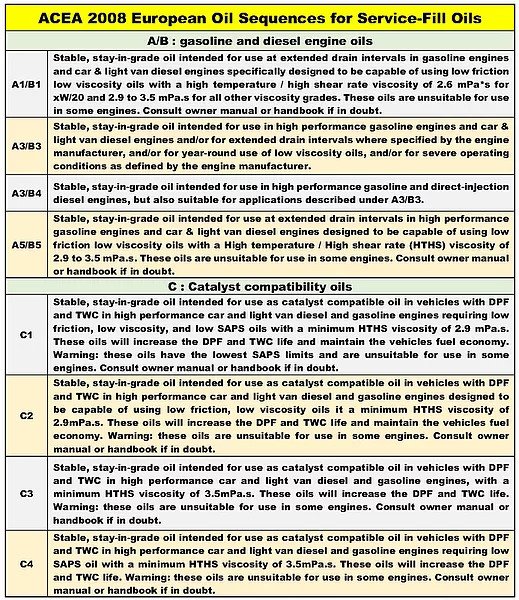
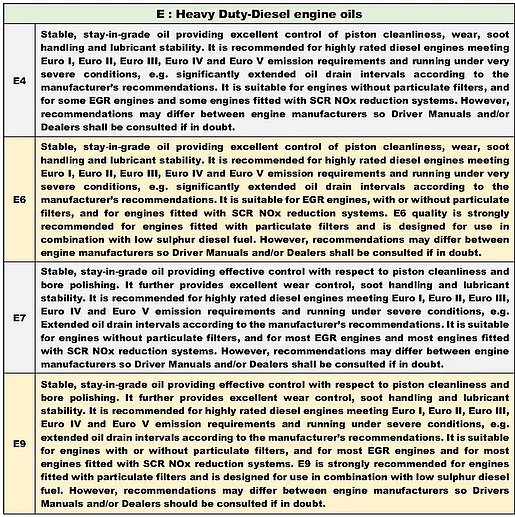
ILSAC ENGINE SERVICE CLASSIFICATIONS
ILSAC (International Lubricants Standardization and Approval Committee) includes the major automobile manufacturers that manufacture vehicles in the USA. This includes the Japanese manufacturers. Effectively, ILSAC specifications are the fuel economy version of the API specifications.
GF-1 is obsolete
GF-2 is equivalent to API SJ
GF-3 is equivalent to API SL
GF-4 is equivalent to API SM
GF-5 is equivalent to API SN
ILSAC grades only apply to viscosities XW-20 and XW-30. GF-4 has introduced a phosphorus limit of 0.08% maximum and a sulphur limit of 0.2% maximum, GF-5 is similar, but it introduced new requirements relating to phosphorus volatility and compatibility with ethanol fuels.
ILSAC, API and ACEA specifications require a large range of engine tests and laboratory tests on the oil. Parameters such as high and low temperature wear, oxidation, soot control, oil thickening, deposit control, volatility, stay in grade performance, fuel economy, chemical composition and many others are tested against limits and rated.
In the case of the API, the oil specifications become more severe as the letters climb the alphabet, eg SL is more severe than SJ. This is not necessarily the case with ACEA as their specifications are more application specific.
TWO STROKE OILS
AIR COOLED
These are low ash or ash less oils depending on the end use. Products can be used in oil injection systems or premixed with the fuel. As they are consumed with the fuel, two stroke oils must not cause excessive combustion chamber or piston deposits, or engine failure may result. The most common two stroke specifications are air cooled.
API TC
ISO EG-B/JASO FB provides good protection against scuffing and varnish.
ISO EG-C/ JASO FC as per EG-B/FB but it has severe restrictions on exhaust smoke, system blocking and detergency.
ISO EG-D/JASO FD enhanced detergency and varnish protection compared to EG-C/FD.
WATER COOLED
NMMA TC-W3® is ash less oil for two stroke outboard engines. Oils can be licensed to this category.
AUTOMATIC TRANSMISSION FLUID CLASSIFICATIONS
There are no API standards for automatic transmission fluids. Indeed, it is only in recent times that the Japanese have released a general industry standard that stands alongside their individual requirements. (JASO-1A)
GEAR OIL CLASSIFICATIONS
Like motor oils, there are two main classification criteria for gear oils:
• Based on Viscosity (SAE)
• Based on Performance (API, manufacturer's specifications)
SAE CLASSIFICATION
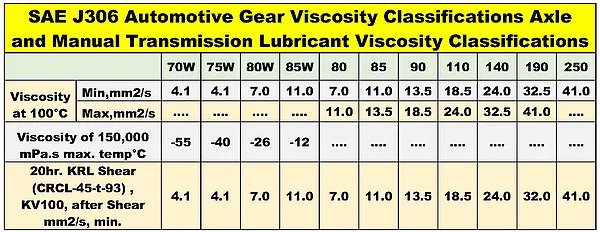

API CLASSIFICATION
For gear oils (loosely including MTFs), there is the below set of standards:
GL-1 Oil without additive
GL-2 usually contains fatty materials
GL-3 contains a mild EP additive
GL-4 Equivalent to MIL-L-2105B and is usually satisfied by a 50%
GL-5 additive level. GL-5 Equivalent to MIL-PRF-2105E. Primary field service recommendation for Passenger cars and trucks worldwide.
GL-6 for severe service involving high offset hypoid gears. Often used to describe oils used in limited slip differentials.
MT-1 For non-synchronized manual transmissions in buses and trucks at a higher level than GL-4. GL-2, GL-3, and GL 6 are not normally used for automotive applications.
MIL-PRF-2105E – designed by the US military it takes conventional GL-5 and adds more demands to the specification. Most hypoid oils conform to this standard.
AGMA SPECIFICATIONS FOR GEAR LUBRICANTS
The American Gear Manufacturers Association (AGMA) has issued specifications and recommendations for gear lubricants used in various types of gear application. AGMA Standard 250.04 details specifications for rust and oxidation inhibited (R and O) and extreme –pressure (EP) Lubricants used in enclosed gear drives.
The viscosity brackets correspond to those given in ASTM D 2422 ‘Standard Recommended Practice for Viscosity System for Industrial Fluid Lubricants’.
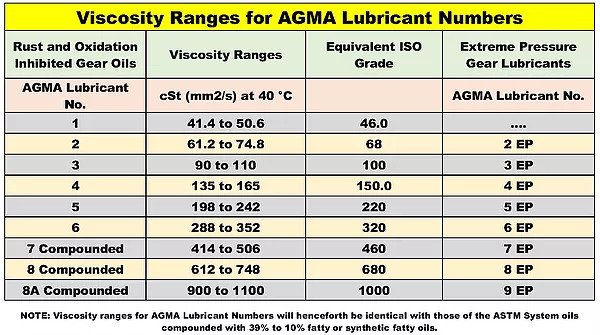
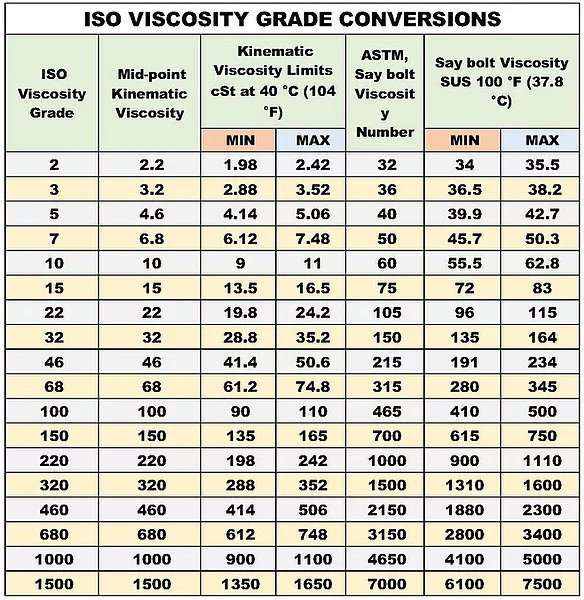
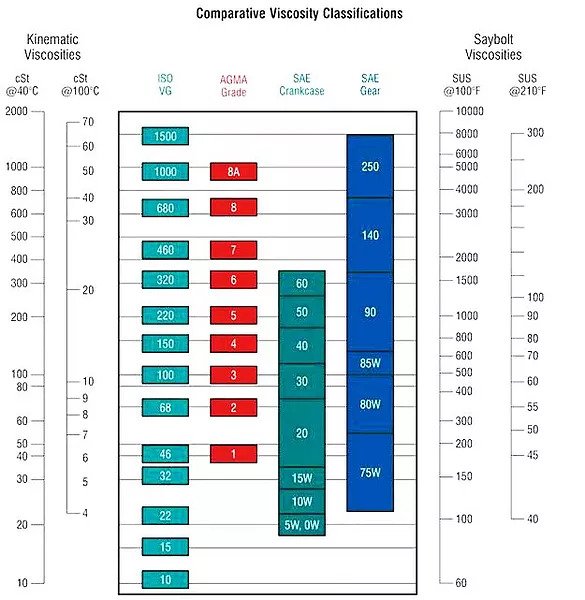
BASE STOCK VISCOSITY




